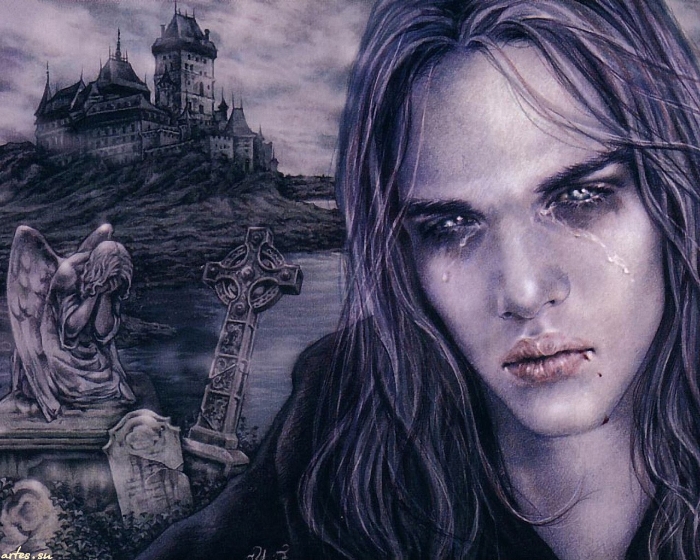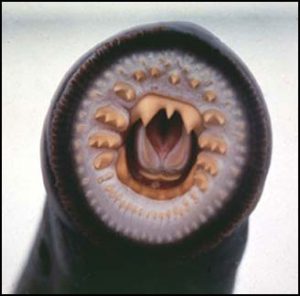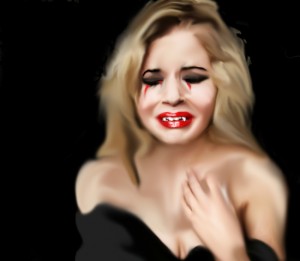My introduction to vampires came by way of a “non-fiction” book I read when I was around 9 or 10 years old. We’re going back 30 years, so damned if I can remember the title, but it did affect how looked at vampires.
By the time I read the book, I had already watched plenty of edited-for-TV horror movies, courtesy of channel 50’s Saturday Shocker lineup. I’d already read a few Stephen King books (hey, I was precocious). In my world, then as now, vampires were monsters. Horrible, hideous, lurking monsters.
This is why I hate fangst.
“Fangst” is a term I read on the Internet, but am having a hard time finding a source. Not to be confused with the IKEA storage device of the same name, let’s say “fangst” is an ironic term one may apply to the depiction of vampires as tragic heroes: beautiful, dark creatures doomed to a life they wouldn’t choose (if they had a choice), grappling with their natures as killers while hand-wringing about being…
What? Beautiful? Seductive? Perfect (except that one little thing, and what’s some murder among immortals)?
Boo fucking hoo.

I came of age in the late 80s/early 90s, which, pre-Twilight, coincided with the rise of the Romantic Vampire. Anne Rice, for better or worse, introduced the idea of “romantic” vampires in the 1970s, with Interview with the Vampire.
But I grew up in a small town and didn’t read that book (although my mother bought it from a book club and it had sat on the shelf for most of my life) until I was in my late teens. The “romantic” vampire reached my little horror bubble with the release of two movies: the film version of Interview, and Bram Stoker’s Dracula.

At least Gary Oldman had teeth (that is, balls). And mystery. He wasn’t pretty, nor was he dating material. He would blow into your room at night and eat you while you screamed. And he was, most appropriately, staked in the heart at the end of the film.
Leaving out the phallic interpretation, the best part for me was always when the ragtag bunch of monster hunters tracked down the vampire and staked it in the heart.
Sometimes it turned to dust and blew away (except for the teeth or the bones). Sometimes the head got cut off or the monster was dragged into the sunlight and it would explode.
Many of my university friends played the White Wolf Vampire game. Not only were they players, an inordinately large amount of time seemed dedicated to a hobby that I thought silly at best.
They spent Saturday night playing. Sunday they would go out for breakfast and talk about the game. Monday and Tuesday would be spent planning, Wednesday and Thursday would be spent shopping and getting their costumes together. Then on Friday, they would go to the local goth bar, get drunk, and talk about what they’d spent the whole week doing. And then it would all start again.
I get it, really. You find something you like and you and your friends get obsessed with it. This was pre-Facebook and social media, so I suppose at least it was face to face interaction. And I’m sure I’ve obsessed for longer over less.
But when characters—vampire characters, no less—were assigned some mopey tragic back story, that’s when I had to step back and ask just why in the hell these bloodsuckers weren’t evil. They weren’t the vampires I recognized and loved at all.
And then came Twilight.
The books and their weaknesses have been deconstructed, parodied, and analyzed to death. The funniest is Sparkledammerung, so I’ll give you the link, for your reading pleasure.
I think the Twilight concept is no dumber than anything we were doing in the 90s, but the books did open the door for a surge in vampire popularity. Suddenly, and most confoundedly, vampires everywhere had become these hipster-emo-oddball flowery smelling, sparkly wimpy teens that girls wanted to date. Not just fuck. DATE! And MARRY! GUH-ROSS!
What’s that? Why gross? Let’s revisit the vampire “non-fiction” book I read as a kid.
Vampires are bodies that have been drained of blood, to the point of death. Then (depending on the mythology), the vampire that “makes” them either bites them or forces them to drink. Either way, what you’ve got is a reanimated corpse.
They’re cold. How they could possibly smell like flowers is beyond me, unless they’re the rotted flowers you find on gravestones. And when was the last time you tasted blood? To me, a dead thing that exists on blood must taste and smell like the clot you might swallow when you get a nosebleed, to say nothing of the viscous, coppery, occasionally clotty stuff of menstruation.
GROSS GROSS GROSS! And this is the thing I’m supposed to find sexy? Kill it! Stake it in the heart! If I ever found a reanimated corpse in my bed, that’s the first thing I’d do. Or set it on fire.

That whole “it feels good when they bite you” nonsense is another head-scratcher. Leeches have something in their sucker mouths that releases an anaesthetic when you get bitten, so you don’t really feel it going in. Does anyone find leeches sexy? Or tragic Byronic heroes? No, they’re disgusting parasites, along with fleas, ticks, mosquitoes, and anything else that drinks blood to survive.
Have you ever pulled ticks off your dog? Try it sometime. A few dozen bloated, headless insect bodies with wriggling legs will put all thoughts of romance completely out of your mind. Especially if you stab them with a nail file and they keep on wriggling (they also look like lima beans, which is something else I can’t stomach). No passion there.
As a writer, in case you haven’t noticed, I have a penchant for body horror. I’m sure some small part of that goes back to the aforementioned vampire book.
I remember reading about people in backwoods Eastern Europe, who believed their dead relatives might come back unless they cut off their heads or put bells beside the coffin. I remember what an horrific thought it was, that someone might be buried alive or the idea of the flesh pulling back from their teeth and nails.
And the names of diseases that might cause something like vampirism, particularly Porphyria or Tuberculosis, were exotic and scary Old World words from a time before antibiotics and clean running water. Death was a mystery and people lived short, brutal lives.
For me, when I was younger, vampires embodied that murky fear of something that had no right to exist, and was a sin against nature. Things that, I’ll stress, wanted to eat you.
Even as an adult, with dissections in biology class under my belt, and more of an understanding about Death, there’s no romance in it. Part of me will always be that frightened child with an irrational fear of the dark, hoping the monsters wouldn’t notice or want to eat me.
We can break it down, cut it up and label it to deal with the grosser aspects of dying, but it’s not pretty. At best, I can have a clinical removal from death, or look into the inevitability of my own death with understanding and without fear. But there’s nothing romantic or erotic about it, and vampires will never be that for me.
And this is why I hate fangst.
Selene MacLeod has written short stories for the Vampire Writers Support Group’s anthology, Fresh Blood (“Psych”) and Geek Force Five: Volume Two (“Womb Envy”). She also writes the occasional “Calls for Submission” column for Beverly Bambury, a “book publicist specializing in science fiction, fantasy, crime, mystery weird, horror, comics and other creative pursuits.”

Nice article!
I’ve mentioned this before, but for me I think it all depends on the story. The evil vampire can be just as boring and cliched as the angsty one. One mistake people make with Ann Rice’s vampires is that they are angsty. Part of the point with Interview with a Vampire is that Louis got more than he bargained for with his vampirism and had to figure a way to come to terms with that. But a number of vampires introduced through her series, especially the arrogant Lestat, are far from troubled about what they are. I think it’s become really easy to pin point Rice’s vampires as the source for all things Twilighty but that’s not the case at all. Rice fully presented the danger and cruelty, as well as the possible second guessing, associated with the vampire. For me that’s what made the stories so interesting.
I will admit though, when I finally decided to write a vampire novel (that turned into a series) I wanted to examine the concept from the perspective of a person whose vampirism is a result of his being a victim of circumstance. (this idea shows up in a number of legends. One day you’re walking along, bam you get bit, the next thing your whole life changes. And if you retain your sense of being, which not all did, how much more difficult would it be to get used to that). Those in my stories don’t gain or lose a moral compass simply because of the condition. Those who are brutal in normal life remain so in vampiric “death” (and thus become even more dangerous). Whereas those who are of a more moral bent find themselves trying to adjust who they were with what they are now and what they have to do to survive. It was a direction I had to consider for the project to become interesting enough for me to write. While I don’t like unnecessarily angsty (as in Twilight in which the vampires are eternally young, incredibly strong, rich, and have trained themselves to feed off animals and oh yea, they can actually move around during the day–ooh, it must be awful being them.) I don’t mind introspection, which is what many people have when the life they knew is suddenly ripped from them.
While I find her stories wanting, Stephanie Meyer did exactly what Bram Stoker and others before him did. She took the myths and legends and altered them. It won’t be everyone’s cup of tea, but this reinvention has helped keep the creature as popular as it has been all these centuries.
Which is why I get weary of people telling me what a vampire is and isn’t supposed to be (especially considering the vast amount of legends that are out there around the world). A vampire is supposed to be what the story calls for. Simple. If the story is strong enough (which isn’t the case with the Twilight series) then yes, the vampire will be left wanting.
There are essentially two types of vampire stories: Those told from the perspective of the vampires, and those told from the perspective of the vampire hunters. Sometimes they can mix. But whatever they are, as long as the’re told well I don’t care what the conceit the storyteller uses when telling his/her story.